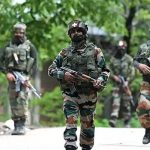Originally published at https://www.tribuneindia.com/news/comment/precision-power-preparedness-indias-new-war-doctrine/
INDIA’S strategic calculus fundamentally shifted on the intervening night of May 6-7, when the Indian Army and Air Force jointly executed Operation Sindoor. Conducted in response to the barbaric terror attack at Pahalgam on April 22, which claimed the lives of 26 innocent civilians, the operation reflected not merely India’s intent to seek retribution, but a clear demonstration of the evolving sophistication and precision of its military capability.
Operation Sindoor was meticulously planned and brilliantly executed, with surgical precision that minimised collateral damage. Nine strategically crucial terrorist infrastructures — five in Pakistan-occupied Jammu & Kashmir (Muzaffarabad, Kotli, Bhimber) and four deep within Pakistani territory (Sialkot, Muridke, Bahawalpur) — were targeted with precision never seen before in the region.
These locations hosted prominent Lashkar-e-Taiba (LeT) and Jaish-e-Mohammed (JeM) training camps and command centres, the centres for terrorism orchestrated against India.
The joint operation exemplified superior inter-service coordination — an operational hallmark vital for modern military successes.
Around 70 per cent of the targets were precisely neutralised by the Indian Army employing drones and advanced precision-guided munitions, highlighting the increasingly crucial role of unmanned systems in contemporary conflicts. Seven targets were destroyed by the army, while the air force complemented this action by using standoff precision weapons against approximately 30 per cent of the designated targets.
Importantly, this joint effort deliberately avoided Pakistani military installations, signifying restraint and measured intent. The international community promptly recognised this nuanced approach — Israel supported India’s right to self-defence, the UAE urged restraint and dialogue, while the US called for a swift resolution to prevent further escalation. Such support shows the legitimacy India enjoys when responding decisively, yet responsibly, to provocations.
However, a word of caution for Pakistan: this restraint should not be mistaken as our weakness. Any further adventure will be responded with far greater intensity and ferocity.
In contrast, Pakistan resorted to false propaganda and disinformation to mask the extent of its operational losses. Within hours, Pakistani military spokespersons and media outlets claimed to have shot down five Indian fighter jets and falsely asserted the capture of soldiers as prisoners of war. These fabricated narratives were debunked by independent analysts and fact-checkers.
For instance, purported images circulated by Pakistan were traced back to an unrelated MiG-29 crash in Rajasthan in 2024; Pakistan’s Defence Minister Khawaja Muhammad Asif retracted initial claims of captured Indian personnel. Such misinformation reflects Pakistan’s strategic pattern — attempting to deflect from its own tactical and operational failures by misleading its domestic populace and international community.
Operationally, Sindoor achieved several objectives. The foremost was dismantling major nodes of Pakistan’s cross-border terror apparatus, significantly degrading their operational capabilities and disrupting potential terrorist plans.
Secondly, the seamless coordination between the army and the air force displayed India’s progress towards true jointness, essential for future engagements. Thirdly, it sent a robust message of deterrence to Pakistan’s deep state: terror sanctuaries, no matter how deep inside Pakistani territory, are no longer safe. Lastly, the strategic messaging to Pakistan to mend its ways or face greater consequences. The N-card will not work anymore.
Yet, the end of one operation is merely the beginning of strategic vigilance and preparedness for suitable response to any pushback. Pakistan’s historical responses to India’s retaliatory military actions exhibit a pattern of irrational escalation and reckless provocation. After India’s 2016 surgical strikes, Pakistan denied that any strikes took place, while simultaneously increasing ceasefire violations by 200 per cent and intensifying terrorist infiltration.
Following the 2019 Balakot strikes, Pakistan’s air force retaliated, causing escalation risks, and proxy infiltrations intensified dramatically. Such behaviours clearly illustrate Pakistan’s strategic irrationality, driven less by coherent statecraft than by domestic political compulsions and ideological compulsions embedded deeply within its military-intelligence establishment.
Thus, India must brace for potential escalation from Pakistan in two domains: direct military confrontation and intensified proxy terror strikes. Pakistan may escalate artillery or rocket fire along the LoC, attempt airspace incursions or resort to sensationalised media theatrics to provoke India.
More dangerously, and far likelier, will be asymmetric strikes by proxies against India’s dual-use infrastructure — communication centres, energy installations and transportation hubs — using low-cost, high-impact drone technologies or other asymmetric tactics, as evidenced by recent global conflicts, notably in Ukraine.
Indeed, the conflict in Ukraine demonstrates the effectiveness of drone warfare — drones accounting for over 70 per cent of battlefield casualties and effectively neutralising expensive, conventional platforms. This drone-driven asymmetry, reshaping global conflicts, must inform India’s immediate threat assessments and strategic posturing.
Moreover, China’s naval drone developments, exemplified by its new Type 076 drone carrier, indirectly compound regional threats through potential technology transfers to Pakistan.
India, therefore, needs decisive strategic recalibration. Immediate operational preparedness must focus on drone and counter-drone technologies, precision strike capabilities and sophisticated AI-enabled command and control structures.
The defence reform agenda must gain urgency. Given Pakistan’s propensity for irrational escalation, reforms and robust deterrence capabilities are strategic imperatives, not optional policies.
Operation Sindoor symbolises India’s strategic evolution. The challenge is to sustain the momentum of this transformation and pre-emptively prepare for potential escalations by an adversary known for irrationality.
As recent events underline, India’s security and standing hinge upon decisive military modernisation and strategic preparedness. The time for incrementalism is past; India must adapt swiftly and strategically to secure a peaceful yet robustly defended future. Because in geopolitics, countries only respect brute power.













